|
Light-cone Surveys
Five separate light-cone 'sky' surveys are produced by each run. Their
properties are summarized in the following table -
Lightcone geometry : LCDM
| Survey type |
Angular coverage |
R_max(Mpc/h) |
z_max |
| octants |
pi/2ster |
3000 |
1.46 |
| oct+wedge(*) |
pi/2 ster |
6000 |
6.8 |
| spheres |
4pi ster |
1500 |
0.58 |
| deep wedge |
100 sqdeg |
5100 |
4.37 |
Lightcone geometry : tCDM
| Survey type |
Angular coverage |
R_max(Mpc/h) |
z_max |
| octants |
pi/2ster |
2000 |
1.25 |
| spheres |
4pi ster |
1000 |
0.44 |
| deep wedge |
100 sqdeg |
3400 |
4.60 |
* available for LCDM only. The POW survey is a combination of the PO
octant (extending to z=1.46) plus a 16x76 sq deg wedge extending to twice
the simulation cube length (6000/h Mpc) using periodic boundaries. The
center of the wedge is co-aligned with the x-y diagonal plane in the simulation
cube.
The surveys are centered at the following locations in the original simulation
cube (mapped to 0-1 interval) -
 larger
version larger
version
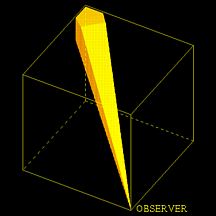 DW has origin (0,0,0) and is directed toward (1,1,1)
DW has origin (0,0,0) and is directed toward (1,1,1)
 larger
version larger
version
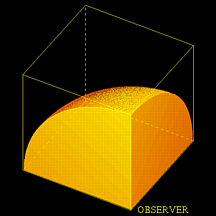 PO has origin (0,0,0) and is directed toward (1,1,1)
PO has origin (0,0,0) and is directed toward (1,1,1)
 larger
version larger
version
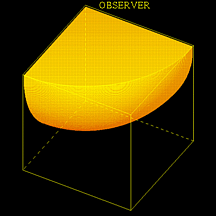 NO has origin (1,1,1) and is directed toward (0,0,0)
NO has origin (1,1,1) and is directed toward (0,0,0)
 larger
version larger
version
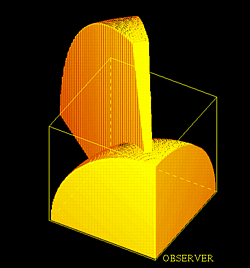 POW
has origin (0,0,0) and is directed toward (1,1, POW
has origin (0,0,0) and is directed toward (1,1,
 larger
version larger
version
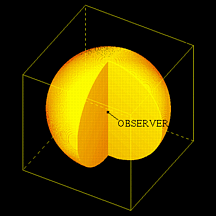 MS
has origin (0.5,0.5,0.5) MS
has origin (0.5,0.5,0.5)
VS has origin (0,0,0) and uses octants from that location plus the 7
other vertices (periodic replications of the origin)
Cluster Catalog Files 
Cluster catalogs derived from a SPHERICAL OVERDENSITY method applied
to the light-cone particle data. Cluster lists are found in files of the
form
grpSO.d$delta_c/$model.$survey.msort$min
where
$delta_c = { 200, 500 } is the defining density threshold
$model = { tcdm, lcdm } is the cosmological model
$survey = { DW, VS, MS, NO, PO/POW } is the choice of sky survey
$min = { 12, 48 } is the minimum particle count of the cluster
Each file contains cluster information
# m zred sigma
ip x y z vx
vy vz
where
m = number of particles (particle mass is 2.22/2.25e12/h for tcdm/lcdm)
zred = redshift
sigma = measured 1D velocity dispersion
ip = parent flag (see below)
x,y,z = cluster location in SURVEY COORDINATES in 0-1 units
vx,vy,vz= physical peculiar velocity in km/s
In the cluster data sets, survey coordinate systems are defined so that
the survey origins are located at
PO/NO/DW : (0,0,0)
VS/MS : (0.5,0.5,0.5)
Cluster locations in the ORIGINAL cube volume can be recovered by
NO : x -> 1-x
VS : x -> mod( (x-0,5), 1 )
PO/DW/MS : no transformation required
Cluster Finding Algorithm 
Clusters are identified using a spherical overdensity method with the
following steps:
- measure distance to 8th nearest particle = r8
- sort in r8 (increasing order) & identify first particle
- center group on this particle
- sort neightboring particles about this center
- cut particle list at overdensity threshold \delta_c (1)
- flag particles as belonging to this group (2)
- find next particle in r8 list not flagged as a group member
- repeat steps 3 & 4 until max r8 is reached (3)
Notes:
- \delta_c is RELATIVE TO CRITICAL DENSITY \rho_c(z) for both LCDM and
tCDM
- particles can belong to more than one group
- defined by comparing density constrast using r8 to \delta_c threshold
### LIMITATIONS ###
No attempt is made to clean near boundaries of the datasets. Some incompleteness
near the planar and radial edges of the surveys is present. If volume
completeness is desired, stay interior to ~3/h Mpc of any boundary.
+ IPARENT flag
The issue of ovelapping clusters is handled as follows. A cluster is defined
to be a parent if it is the largest of any group of clusters with which
it overlaps. Isolated clusters are parents by default. The `family' criterion
employed is that the threshold spheres of pair i & j overlap:
| cen_i - cen_j | <= Rvir_i + Rvir_j
Note that the center of any cluster cannot lie within the threshold radius
of any cluster other than itself.
Additonal Cluster Data
The catalog files are shortened versions of the original group finder
output. The group finder processes planes of cubes in the Z-direction.
Separate output files for each Z-slice are produced. These files can be
made available upon request.
For each slice iz, there are three output files:
- z$iz.base : basic cluster data
- z$iz.extra : internal cluster structure data
- z$iz.iparent : list of binary values for iparent flag (see above)
The *.base files contain:
# M {X Y Z}_c {Vx Vy Vz V}_com
sigma1D R R.5 S.5
{X Y Z}_mb
{X Y Z}_com
where
|
M
{X Y Z}_c
{Vx Vy Vz V}_com
sigma1D
R
R.5
S.5
{X Y Z}_mb
{X Y Z}_com
|
= cluster mass in particles (1 particle = 2.2e12/h Msol
in both models)
= cluster center (1)
= center-of-mass velocity components and speed (2)
= one-dimensional velocity dispersion (2)
= cluster radius (1)
= ratio of half mass radius to full radius R_{1/2}/R
= ratio of velocity dispersions within R_{1/2} and R
= position of most bound cluster member (1,3)
= position of cluster center-of-masss (1) |
Notes:
- in box units (L=1). Box is (2/3)000/h Mpc for (t/L)cdm models.
- in km/s
- determined using N^2 sum of potential among group members only.
The *.extra files contain moments of the internal density and velocity:
# {Rxx Rxy Rxz Ryy Ryz Rzz} {Vxx Vxy Vxz Vyy
Vyz Vzz}
where
Rij = Sum_k (R-R_c)_i (R-R_c)_j / M
Vij = Sum_k (V-V_com)_i (V-V_com)_j / M
and the sum is over members k running from 1 to M.
The *.iparent files contain the integer iparent flag for each cluster.
Original text file written by August.E.Evrard.
Comments to: Virgo Administrator  virgo@mpa-garching.mpg.de virgo@mpa-garching.mpg.de
|


